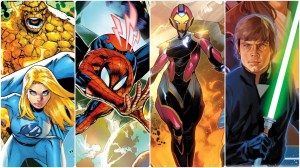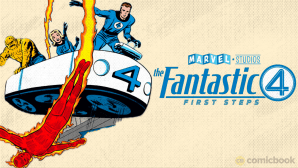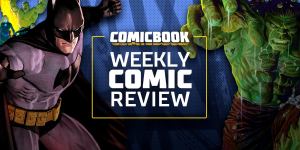A Suggested Artist’s Edition
This year at San Diego Comic Con, IDW announced a new Artist’s Edition featuring Jack Kirby’s Fantastic Four. It has two complete issues plus an Annual, and will likely be filled out with random splashes or covers or something. As a lot of people think “Fantastic Four” is Kirby’s best work, this is cause for some excitement.
Videos by ComicBook.com

Everyone has ideas for what they’d like to see in a new Artist’s Edition, most of which usually fail one of the two big rules of the series: there must be original art available from it (obviously), and computer lettering is a no/no. That latter rule has proven a little more flexible, but still not preferable. But, hey, if there can be a “Chris Samnee’s Daredevil: Artist’s Edition”, then I think that wall is falling fast.
I thought of a book that, barring that lettering issue, might also make for an awesome Artist’s Edition: CrossGen’s “Ruse.” It’s owned by Marvel’s owners, so there’s already a business relationship there. And, good news, there’s one super collector who owns A LOT of the art from the series. We just need to get past the lettering problem and fill in the gaps from the pages that collector doesn’t own, and you’d have an awesome book.
Plus, those first five issues make an excellent single story.
In the meantime, we can all go back to waiting for a second volume in the “Bone” and “Uncle Scrooge” series…
And now for a quick round-up of all the other interesting comic news out of San Diego:
That is all.
Wait, What Is a “Big Announcement” Anymore?!?
It dawned on me recently that, while I miss the days of big comic book announcements coming out of San Diego, I couldn’t think of what a big announcement would even look like anymore.
The very definition of every “big announcement” from DC and Marvel is a new company wide crossover that’s going to change everything about their universes.
But they do those every year, and have for the last decade. What’s so interesting about the next one? “This time, we’re resetting everything for good, and we mean it! (Until next year’s big event…)”
Are alternate covers a big event? Is the announcement of a new series or mini-series created to tie into the upcoming movie a big thing? I don’t really think so.
Maybe if a company announced they were doing away with single issues and going all graphic novels and digital only, it would be grist for the mill. But I hardly think we’re going to see anything of that magnitude anytime soon.
Bah, let Hollywood have the convention.
Doctor Strange: The Comic, Not the Movie

The current Jason Aaron/Chris Bachalo “Doctor Strange” series has its first collected edition, titled “The Way of the Weird.” It only collects five issues and it ends in the middle of a story, but it’s an entertaining read that’s visually spectacular.
I’m not a big “Doctor Strange” fan. I don’t think I’ve ever seen the excitement that others see in the character. Magic doesn’t do much for me, perhaps because it’s one of those things that gives a writer a chance to make up literally anything and get away with it.
Big world-ending problem? Wait, there’s a forgotten spell the character can conveniently remember to save the day! The magician is backed into a particular corner and the spells he’s throwing aren’t landing? That’s OK, just make up a new one and have that one win the day.
It’s like trying to get excited about a poker movie, where there is no sense of unpredictability. The cards are being drawn to service the story.
Aaron’s “Doctor Strange,” instead, sells us on a big story in two parts. The first is that magic is always surrounding us and that it explains so many everyday occurrences we could never figure out. The second is that magic is strewn throughout the universe, and that there are several Sorceror Supremes out there, forming a brotherhood of sorts. It’s less about casting the right vaguely Latin-sounding spell at the right time, and more about this new facet of reality we hadn’t previously considered, as well as the larger magic mythology in the Marvel Universe that brings together the most powerful magicians in Marvel Comics.
That’s all the blimp level view of stuff. The ground level view that makes this version of the character in this series so enjoyable is his personality. This Doctor Strange is self-aware, knowing that what he says and does aren’t “normal” and that his life is very strange, indeed. He can be flippant about the magic around him, voicing a kind of disbelief that the reader might have with the whole set-up, too. It helps draw the reader in.

The other half of that equation is the new point of view character, Zelma Stanton, who is a librarian from the Bronx who has an unfortunate magical mystical creature thingy popping out of the top of her head. She seeks Strange’s guidance, only to get swept up into his world.
I can see the point of having her in there to be the grounded person in a series that’s overwhelmingly magical, but Strange’s attitude and narration does a pretty good job at keeping things grounded, too. He realizes how much of the stuff he gets caught up in is just plain crazy. He has a lighter touch with his narration and his dialogue, which is more welcoming than a straight serious magician with a complex would be.
Zelma provides an extra point of view that I imagine will come in handy at some point, plus the ability for Strange to interact with someone who doesn’t know it all, challenging his beliefs and giving him an outlet for necessary exposition.
In any case, she gets involved in this world and ends up taking a slightly more active role at the end of the first story arc. She’s an interesting addition to the cast, but I hope Aaron has some more plans for her, too, beyond being just the point of view character.
The weak part of this collection is that it ends in the middle of a story. When there’s grave terrible danger to the master magicians in the universe, Strange is forced to rally the troops to fight back and — the book ends. Yes, it’s a cliffhanger that makes me want to read more, but I’ve become used to comics series that are better designed to be read in six (or five) issue chunks. This one just comes to a stop in the middle of ascending action. That’s weird in this day and age to me.
The big star of the book is Chris Bachalo’s art, which he’s also coloring while an ever-increasing team of inkers is brought in to ink it from issue to issue. He inked his own work in the first issue, then a team of three inkers steps in for the next couple of issues, before increasing to six inkers for the fourth and fifth. The good news is the overall quality of the art doesn’t suffer for it. I can’t see any major differences. There’s a lot on every page, but what’s the situation in production like that it requires six inkers to push the work out every month? Does Bachalo not let go of all the pages until he’s penciled every last one of them?

Bachalo’s art is often busy and sometimes dizzying, but is unlike anything else in comics today. He can ornately decorate his pages, whether it’s with random magical branches snaking across pages in the gutters, or little creatures hanging out around panels. His panel compositions are amazing, with great compositions that freeze moments beautifully. He can go from densely detailed panels to floating blank spaces with characters acting in front of them that still tell a story well. He fits a lot on the page without making it too hard to understand. You just need to concentrate on the art a little more than other artists’ work.
One drawback to reading Bachalo’s art — especially digitally in a two-page screen format — is that the definitions between pages sometimes throw me off. Bachalo will go full bleed on random panels, often with ones that butt up against facing pages where random panels also bleed out to the edges. It can sometimes look like one large panel that’s sharply divided. Again, you need to pay attention and see when he’s going for a double page spread, and when it’s just an unfortunate combination of panels leading into each other accidentally.
But as far as overall page design and storytelling — camera placement, lighting — as well as cartooning, Bachalo’s artwork sells the comic by itself. It’s an experience worth paying for. Thankfully, Jason Aaron’s story is interesting, too, with a sharp first couple of issues that drew me into a character I’ve always kept at a slight distance.
I’m interested now; please show me more. And please finish a story in volume 2!
PipelineComics.com || Instagram (NEW!) || Twitter || E-mail





